TABLE OF CONTENTS
Dehydration
The literal meaning of dehydration is the loss of water from the body. It is also defined as a fluid and electrolyte imbalance or loss of fluid and electrolytes.
70% of the body is made up of water, and this water is composed of various solutes (electrolytes). About 50% of this water remains intracellular, and the remaining 20% is considered to be extracellular.

Extracellular component which is very vital which is again divided into:
- Interstitial fluid – 15%
- Circulating fluid (Plasma) – 5%
It is usually presumed that interstitial fluid and plasma ratio is 3:1.
As per WHO, the dehydration is defined as loss of water and the dissolved solutes from the body by physiological and pathological means.
Normally the water is lost from the body through various means like skin (sweating), faeces, urinary output and to lesser extent through respiration.
Clinical dehydration can be an outcome of either of failure of water intake or excessive loss of water.
Failure of water intake
- Water deprivation
- Decreased activity of thirst center
- Due to ongoing toxemia and debility which causes lack of thirst
- Due to certain pathological conditions which affect deglutition process:
- Enlargement of retropharyngeal lymph node
- Simple stomatitis
- Laryngitis
- Oesophagial paralysis
- Rabies (pharyngeal paralysis)
- Epimeral fever (transitory esophageal paralysis)
- Choke (Oesophagial obstruction)
- Phlegmon (inflammatory swelling of pharynx)
Excessive loss of water
Any condition which results in gastritis or enteritis resulting in a vomition or diarrhoea. Bacterial and viral diseases are responsible. For example, BVD, RP, Winter dysentry, Salmonellosis, Parasitic diarrhea, CD, ICH etc.
Malabsorption syndrome: Parvo viral gastroenteritis causes villous atrophy, which leads to a decrease in the absorption of the digested food and frequent passage of voluminous faeces.
Systemic conditions like ruminal lactic acidosis, abomasal displacement, intestinal obstruction, excessive diuretics, and any condition that causes polyuria, like CRF, DM, pyometra, etc., cause excessive loss of water.
Electrolyte imbalances noticed in dehydration:
- Sodium: The loss of Na during dehydration is termed as hyponatraemia. The most common cause of this is enterotoxigenic colibacillosis especially in case of young one.
- Chloride: Hypochloremia, loss of chloride ion which usually occurs as a result of net loss of chloride in the intestinal tract. The common causes are acute gastric dilatation in small animals, torsion & displacement of abomasums in large animals. In all these cases large quantity of Hcl is secreted resulting in net loss of cl
- Potassium: The cause of hypocalcemia includes abomasal stasis, which is a sequel of pyloric stenosis, upper intestinal obstruction & renal disorders.
Clinical dehydration is classified into three types:
- Isotonic type
- Hypertonic type
- Hypotonic type
1. Isotonic type of dehydration
In this Isotonic type of dehydration, there is an equivalent loss of water and solutes. Basically sodium being important extracellular component reduces in ECF.
Examples of Isotonic type of dehydration are: Acute gastro-intestinal disorders, fluid and food deprivation, repeated draining of fluid in ascietis and profound sweating also results in this type of dehydration. There is no compensatory transfer of water from ICF to ECF and usually such type of dehydration is treated with isotonic fluid like NS/DNS. Depending upon the clinical manifestation other fluids like RL can also be supplemented.
2. Hypertonic type of dehydration
Water depletion type of dehydration. Excessive loss of water without much loss of sodium.
Examples of hypertonic type of dehydration are: Diabetes insipidus. 5% dextrose as a parenteral fluid indicated.
3. Hypotonic type of dehydration
Hypotonic type of dehydration results due to sodium depletion. Here there is more loss of sodium along with water. Usually it is severe type of dehydration and requires emergency treatment common clinical condition which brings about this condition is acute gastroenteritis due to colibacillosis, salmonellosis, acute gastric dilatation, acute intestinal obstruction and diabetic coma. Treatment is preferably carried out by hypertonic NaCl solutions (2-5%).
Various degrees of dehydration

Electrolyte Estimation
Electrolyte estimation gives correct electrolyte imbalance occurred in the dehydrated patients. Plasma bicarbonate estimation is very much important in case of enteritis. Normal level is 24-30 milli mol/litre. In metabolic acidosis there is bicarbonate deficit & this metabolic acidosis can be graded as mild, moderate & severe depending on charge in bicarbonate concentration.
- Mild dehydration: 24-18 mmol/litre
- Moderate dehydration: 14-18 mmol/litre
- Severe dehydration: <10 mmol/litre
Clinical Signs
Clinical Signs in mild dehydration
Clinical signs are minimum but other compensatory mechanism counteracts dehydration. Indicate hurried type of respiration, mild change in PCV/hematocrit value (mild increases) by about 4-5%.
Clinical Signs in moderate dehydration
Show mild signs of eyeball sinking, skin fold test remains elevated for about 2-4sec. & haematocrit value are elevated by 5-10%. Body surface is warm but extremities are cold.
Clinical Signs in severe dehydration
Animal is recumbent most of the time in the state of shock, mucosa congested, body surface as well as extremities cold indicating the case is advancing towards peripheral circulatory failure. Skin fold test remains elevated for about 10 sec. Hematocrit value is increased by about 15-20%.
Treatment of dehydration
Treatment of dehydration involves restoring the fluid through fluid therapy.

